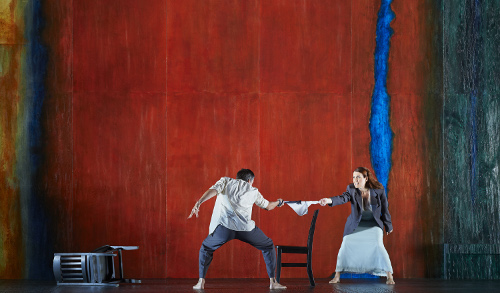 Toronto’s Canadian Opera Company presents Barbara Monk Feldman’s original opera Pyramus and Thisbe
Toronto’s Canadian Opera Company presents Barbara Monk Feldman’s original opera Pyramus and Thisbe
Two star-crossed lovers parted by a wall, able to communicate only through a tiny hole: so goes the story of Pyramus and Thisbe, a tale beloved enough for Shakespeare to use (and deliberately mangle) it in his play-within-a-play in A Midsummer Night’s Dream; now it finds a home with the Canadian Opera Company at the Four Seasons Centre in Toronto.
But the COC’s production isn’t a literal take on the story; rather, it takes a more metaphysical approach, preferring to play with structure in a work of curious irresolution and ambiguity. It certainly is a bold vision, but for me, the results were mixed.
First off, Pyramus and Thisbe is actually comprised of three pieces. First, a fragment of Claudio Monteverdi’s L’Ariana, depicting the story of Ariadne and Theseus of Greek antiquity. Second, we have another Monteverdi piece, Il combattimento di Tancredi e Clorinda, which recounts the story of Clorinda, who confronts her Christian crusader lover on the battlefield. Third is the world premiere of Pyramus and Thisbe, a new one-act opera composed by Barbara Monk Feldman.
Some of the most interesting parts of this production are the transitions between these pieces. The narrative lines blur early and often between the three sets of lovers, and as one section finishes, the beginning of the next seems to bleed over, dissolving narrative walls in a way that complements what seems to be the overall theme of the piece: transgressing boundaries, be they physical or metaphysical, in an effort to transcend the endless, echoing, aching pursuit of human connection.
Make no mistake, the production have several striking moments: Thisbe stepping off the stage ranked as my favourite, as she defies the echoing tragedy of the previous two pieces. She draws Pyramus off with her, and they lie in the stylized light of the stage door exit sign in a neat moment of metatheatricality.
There can also be no complaints as to the sound of the piece. From Montiverdi to Monk Feldman, the orchestra was lush, the chorus grand, and the score haunting. Krisztina Szabó is achingly beautiful as Thisbe, Clorinda and Ariadne, combining power and vulnerability with nuance in each role. The talented ensemble ensures that it sounds like heaven all around.
Despite all this, however, I found the production difficult to connect with emotionally. The staging is very stylized: there’s a lot of slow pacing around the stage, a lot of strange interactions that often don’t seem to connect with the text being sung. At one moment, for example, the libretto tells us that Tancredi lies on his back, but we watch him rising to his feet; we are told the battling lovers are exhausted while we watch Clorinda casually smoke a cigarette against the wall. I often felt locked out emotionally: how was I meant to read the characters’ body language, what were they feeling, why were they not looking at each other, how was I supposed to interpret the way they were relating to each other?
Perhaps this was the point; perhaps it was meant to emphasize the disconnectedness of the lovers. The Ariadne story, though the simplest in terms of staging, does the best in this respect, as Szabó is allowed to simply sit and emote in isolation; the second is a bit more dynamic in terms of action, but began the process of locking me out of its characters’ motivations; by the time we got to Pyramus and Thisbe, I found it incredibly difficult to find the human element to this story of boundaries and cycles, so bound up was it in metaphysical ponderings and carefully constructed motion.
I think this is a production that favours intellectualism over anything else—and in that respect, it does generate some provocative ideas. But I never felt anything. The production left me cold; it never spoke to me, never extended that hand to let me fully in on the experiment. Think, it seemed to say, uncaring of whether or not I felt anything in the process.
Do be warned, too, that it plays best if you have some familiarity with the stories before going in. This isn’t a problem, so long as you remember to read the program beforehand (my guest, alas, hadn’t).
I suppose this is a matter of taste, in the end. Intellectual experiments like this one are always risky, and Pyramus and Thisbe is certainly a bold vision with a lot of provocative ideas to share. I just wish it had given me a bit more heart to go with all that brain.
Details:
- Pyramus and Thisbe plays at the Four Seasons Centre, 145 Queen W until November 7th with alternating casts.
- Tickets range in price from $35 to $239, with discounted tickets available for youth through the COC Opera Under 30 program.
- Tickets can be purchased online or by calling 416.363.836
Photo credit: Phillip Addis as Tancredi and Krisztina Szabó as Clorinda in the Canadian Opera Company’s world premiere production of Pyramus and Thisbe (with Lamento d’Arianna and Il combattimento di Tancredi e Clorinda), 2015. Photography by Michael Cooper.
